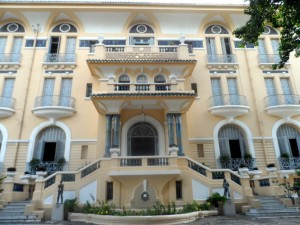Sophie’s Art Tour – Vietnam’s History, Through Artists’ Eyes
Even on the most fleeting visit to Vietnam, it’s almost impossible to avoid learning at least a little about the country’s turbulent history. Nor should you want to. Only through understanding what the country has been through can you begin to appreciate just how far it has come and the huge potential that it has. Sophie’s Art Tour give a unique perspective on this history, presenting the tale of Vietnam through the eyes of its artists. The story she reveals is certainly no less confronting than a visit to the War Remnants Museum but is a far gentler approach.
Last week I was fortunate enough to join Sophie’s tour with five other visitors to Ho Chi Minh City. We met up at a small private room in the beautiful Gao Restaurant, former home of a former plantation owner who’d worked for Michelin during the French Colonial era. He obviously did very well for himself if the beautiful building is anything to go by. Not all the fixtures are original, but the building still oozes the elegance, charm, and prosperity (for some at least!) of that period in Saigon’s history.
Sophie is a softly spoken, Englishwoman with impeccable qualifications and experience in the international art scene. The tour has evolved after more than three years of extensive research. Contributors to the project include artists personally involved in the wars, eminent historians of the different periods, and curators of the art itself. By interweaving their stories, Sophie has crafted a longer narrative that spans two centuries of modern and contemporary Vietnam. It’s a fascinating tale, revealing the power of art for communicating, persuading and rallying whole populations to a cause. From the first introduction, it was pretty obvious this wasn’t going to be just another day tour. With the use of pictures and photographs (presented on an IPad), we were introduced to the broader context of what we would be discovering before moving on to various locations around town.
The story spans from the 1800’s through to modern day and is presented in 4 chapters. Most of the tale is told in the Museum of Fine Arts in District 1. Chapter 1 starts with French colonization in the 1800’s, an era that had a huge impact on Vietnamese cuisine, architecture, and of course ART. Of note was the romanticized version of Vietnam, presented back home in France, which was in stark contrast to the reality of those under French rule. For me, it was the first insight to a theme that would run through the day. Art being used, by the ‘powers that be’, as a tool to change perceptions of the masses.
Next, the story moves onto two Indochina wars. Firstly the war of independence from the French and then onto the Vietnam/American War. This tumultuous period is explored through combat and propaganda art and provides a unique perspective on how Ho Chi Minh utilized artists to further the cause of his people. The connection and support of Russia and China as part of the broader cold war is evident, especially in the Propaganda art.
The tales of combat artists were very thought provoking. Without the resources of the South, like cameras and film, artists took rudimentary tools to the front line, painting scenes of heroism under fire. The general populous of the north were dirt poor. They had no photographs of their children. You can only imagine how much a painting or sketch of their deceased child, portrayed as a hero of the people, would mean to them. It must have been hugely influential in encouraging the largely rural population to take up arms.
The story then focuses on Saigon up until 1986. As the headquarters of the South Vietnamese government, US and Allied forces, it was largely out of the fray for the first half of the war. Foreign troops introduced many of the ‘cultural’ pursuits of the 60’s which filtered into artistic endeavors locally. The TET offensive in 1968 changed the course of the war. The civil unrest and anger that emerged as the Americans pulled out, and casualties for the South Vietnamese forces escalated, was evident in the art. As the end got close, much of the art of this period was destroyed to remove evidence that could be used for retribution. The Museum of Fine Arts is one of the only places you can see it. By the time the Northern forces won in 1975, life, as the southerners knew it, had changed forever. And so did their art. Freedom of expression was no longer possible as the iron fist of communism came down hard.
Of all the things I discovered on the day, most fascinating was how the government of the different periods used art as a marketing tool. Firstly the French with their idealized version of harsh conditions in colonial times. Then the Propaganda campaigns of the War Machines so inextricably linked to the Cold War being waged at the time. Post 1975, the victorious communists had tight reign over all publications. Certainly not much scope for freedom of expression there.
After 1986, with the economy crumbling, the government allowed the country to open up. Commercial enterprise was allowed and flourished in the south. Saigon, once again became a hub for making money. These changes also allowed the artists more creative liberties and once again the art began to reflect the changing times. With conditions quite tough for many, much of the art presented a somewhat nostalgic look at the war. It has since evolved to embrace more contemporary themes. However, war still plays a huge part in public art. To this day, the only government sponsored art prize is ‘The War Prize.’
To round off the day, we visited a couple of galleries around town, heavily involved in cultivating, supporting and promoting the many talented Vietnamese artists, in-country and abroad. It’s a tough road, but a lot of progress is being made to help young artists to break into the local and international scene. Check out Gallery Quynh and San Art for more information. Both have mailing lists and more information on exhibitions and projects.
There is no doubt Sophie has a passion for what she does, and her enthusiasm is infectious. I’ve visited several art museums and galleries around town on my walking tours, but it wasn’t until this tour that I fully appreciated them as an eye into history. A lot of the symbolism had unfortunately escaped me. The way Sophie weaves the tale, pointing out details in the art, and connecting the dots to what was happening at the time, makes the experience spellbinding and not just educational. She has a way of communicating the detail and significance without making the huge amount of information overwhelming.
I’m afraid my musings cannot fully reflect everything I learned on the day. And anyway; Sophie tells it so much better than I ever could. If you have even the slightest interest in art and history or have visited an art museum with the sole outcome of feeling you’ve seen a few nice pictures, then you should take this tour. It will open your eyes to aspects of Saigon and Vietnam you haven’t even considered and will make your visit so much richer. Find out more about Sophie’s Art Tour here.
Note: I do not receive any payment for this post (or any others on the site for that matter!). I do receive a small amount of money by allowing advertisements on the site and any purchases made through those links.















3 Responses
[…] are really interested in Vietnamese History and Art, then skip this step and come back as part of Sophie’s Art Tour. You’ll be amazed at how much the art in this gallery reveals about the last 200 years in […]
[…] Visit the Fine Art Museum – 97 Phó Đức Chính Street, District 1, located in a beautiful colonial building, used to be the residence of a rich Chinese/Vietnamese merchant family. Art on display is interesting, although not as interesting as the Fine Art Museum in Hanoi, however still worth paying a visit. (Editor’s note: For a real exploration of this wonderful museum, take Sophie’s Art Tour.) […]
[…] Sophies Art Tour – A brilliant insight into art and it’s connection with Vietnam’s turbulent history, Saigon Unseen – get out and see a side of Ho Chi Minh City most tourists don’t see, A Shopping Tour with City Treasure Hunt; or Make up your own tour with the help of the free guide service from Saigon Hotpot. Escape Hunt Experience for a fun time if you’re in a group and the weather looks too wild to be outside. […]